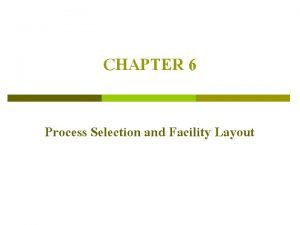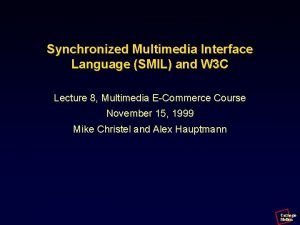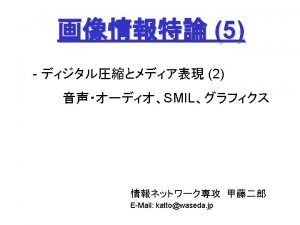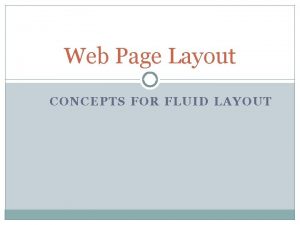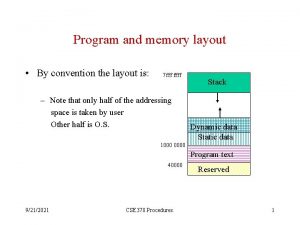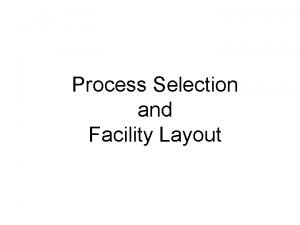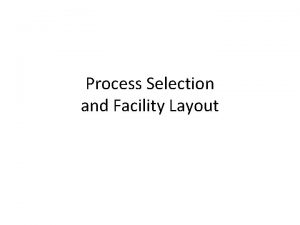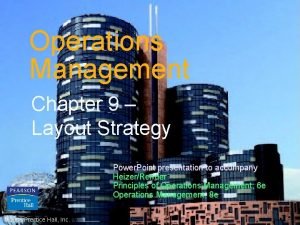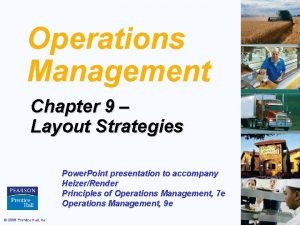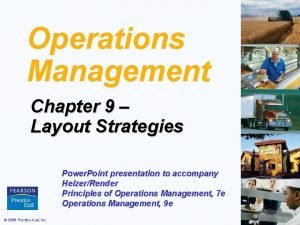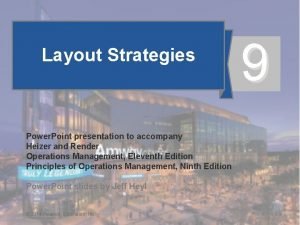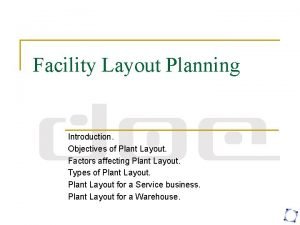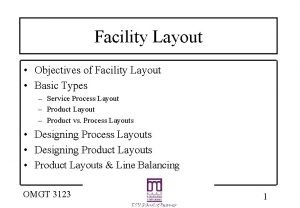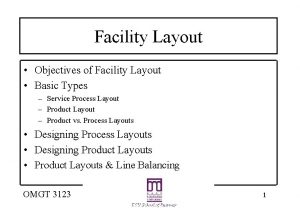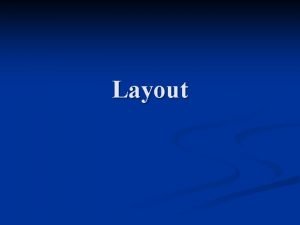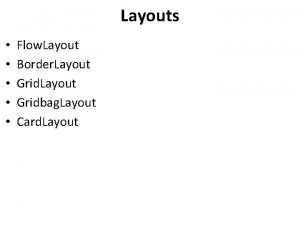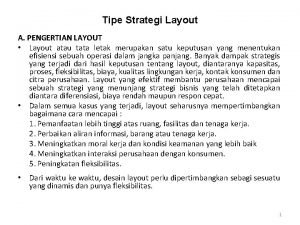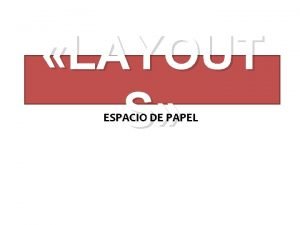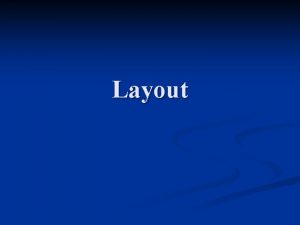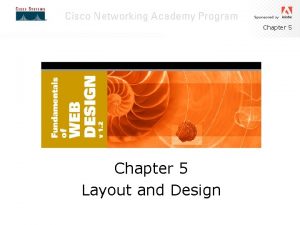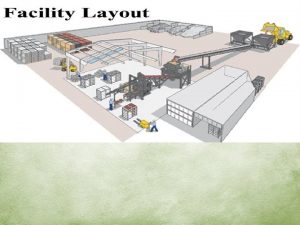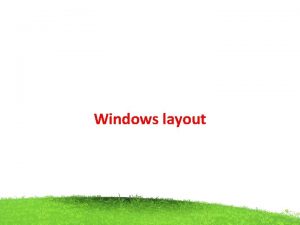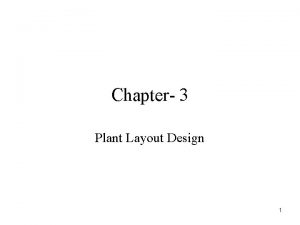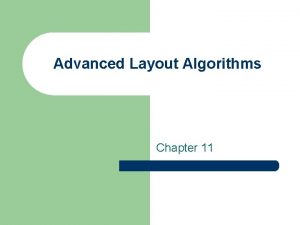Process Layout Chapter 6 Process Layout Process layout















- Slides: 15

Process Layout Chapter #6

Process Layout Process layout is the floor plan of a plant or production facility. Required to improve the efficiency by arranging equipment according to their functions The main idea is to arrange or gather machines or equipments of the same function into one group or department.

Layout Planning that involves decisions about the physical arrangement of economic activity centers needed by a facility’s various processes. Economic Activity Center › Anything that consumes space, for example a person or a group of people, customer reception are, a machine, a work station, a department, an aisle or storage room etc.

Please see page 315 (book-1)for details Layout Planning decisions What center should the layout include? How much space and capacity each center requires? If there is not enough space, productivity may be reduced. Too much space is expensive and may also reduce productivity How should each center be configured? Space quantity, shape, distance and the elements of the work center are related to each other. Where should each center be located? The allocation of the different centers may affect productivity.

Objectives of Layout Planning › › › › › Congestion reduction. Elimination of unnecessary occupied areas. Improvement on control and supervision. Better utilization of the workforce, equipment and services. Reduction of material handling activities and stock in process. Reduction on parts and quality risks. Reduction on health risks and increase on workers safety. Moral and workers satisfaction increase. Reduction on delays and manufacturing time, as well as increase in production capacity. Cost effectiveness

Types of Layouts Please see page 317 (book-1)for details Flexible Flow layout: › A layout that organizes resources (employees and equipment) by function rather than by service or product. › Also known as Process layout. › useful when the production process is organized in batches. › Personnel and equipment to perform the same function are allocated in the same area.

Layout Types Line Flow Layout: › A layout in which work stations or departments are arranged in a linear path. Also called Product layout (Assembly line) › Machinery and Materials are placed following the product path. › Machine are placed as close as possible to the next one in line, in the correct sequence to manufacture the product.

Layout Types Hybrid layout: › An arrangement in which some portions of the facility have a flexible flow layout and others have line flow layout. › Looks for the advantages of product and process layouts.

Layout Types Fixed Position Layouts › An arrangement in which the service and manufacturing site is fixed in place and employees, along with their equipment, come to the site to do their work. E. g. Shipping vessels and aero planes are produced through this layout.

Factors affecting Layout Decision › Materials › Machinery › Labor › Auxiliary Services › Future Changes

Materials The layout of the productive equipment will depend on the characteristics of the product to be managed at the facility, as well as the different parts and materials to work on. Main factors to be considered: size, shape, volume, weight, and the physical-chemical characteristics.

Machinery › Having information about the processes, machinery, tools and necessary equipment, as well as their use and requirements is essential to design a correct layout. › Regarding machinery, we have to consider the type, total available for each type, as well as type and quantity of tools and equipment. › It’s essential as well to know about space required, shape, height, weight, quantity and type of workers required, risks for the personnel, requirements of auxiliary services, etc.

Labor has to be organized in the production process (direct labor, supervision and auxiliary services). Environment considerations: employees’ safety, light conditions, ventilation, temperature, noise, etc. Process considerations: personnel qualifications, flexibility, number of workers required at a given time as well as the type of work to be performed by them.

Auxiliary Services Support the main production activities at the plant: Related to labor: Accessibility paths, fire protection installations, supervision, safety, etc. Related to material: quality control. Related to machinery: maintenance and electrical and water lines. The auxiliary services represent around 30% of the space at a facility.

Future Changes One of the main objectives of plant layout is flexibility. › It’s important to forecast the future changes to avoid having an inefficient plant layout in a short term. › Possible future extensions of the facility must be taken into account, as well as the feasibility of production during relayout.
 Process selection and facility layout
Process selection and facility layout Layout
Layout Denominator layout
Denominator layout Language
Language Smil head layout root-layout
Smil head layout root-layout Liquid layout website
Liquid layout website Process memory layout
Process memory layout Importance of process selection and facility layout
Importance of process selection and facility layout The process of assigning tasks to workstations
The process of assigning tasks to workstations Product-oriented layout example
Product-oriented layout example Interdepartmental flow graph
Interdepartmental flow graph The central problem in product-oriented layout planning is:
The central problem in product-oriented layout planning is: Process layout example
Process layout example Objectives of factory layout
Objectives of factory layout Types of facility layouts
Types of facility layouts Objectives of layout
Objectives of layout
